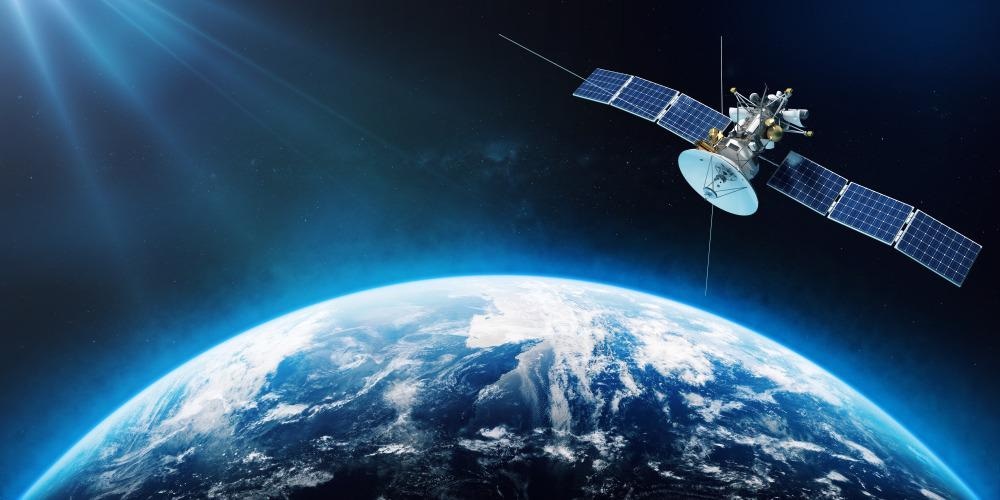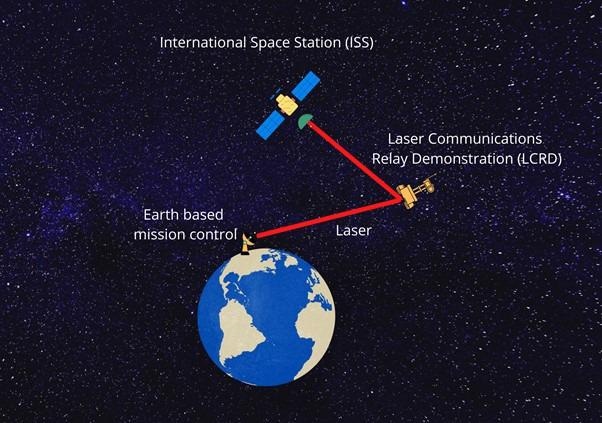NASA has launched a mission to test optical space communication with Laser Communications Relay Demonstration (LCRD).

Image Credit: Boris Rabtsevich/Shutterstock.com
Space exploration is a thriving research industry. Research entities are invested in investigating biology, chemistry, microgravity, and many other areas in space. Commercial flights taking passengers to space are also in their trial stages. With mounting activities in space flight, there is a need to enhance the communication methods between Earth-based stations and space crafts.
Nearly 3,400 active satellites are orbiting the Earth. These satellites are used for Earth-based applications such as mobile phones and GPS navigation. The satellites also use unique radio frequencies (RF) to transmit data. Consequently, there is less RF bandwidth available for other space missions.
NASA has developed an optical space communication system as an alternative to the traditional RF-based communication methods.
Space Communication with Lasers
NASA launched the Laser Communications Relay Demonstration (LCRD) into space in December 2021. LCRD is NASA’s first laser-based space communication system. The objective of LCRD is to test optical communications in space.
Historically, NASA has used RF waves to communicate between space vehicles and ground-based mission commands. For example, when Neil Armstrong first stepped out on the moon in 1969, his famous words: “That's one small step for man. One giant leap for mankind” were transmitted using RF waves.

Radiofrequency waves have been used to communicate during space missions, including the famous moon landing in 1969. Image Credit: Elena11/Shutterstock.com
LCRD will use infrared (IR) laser light to transmit data. IR light waves and RF waves are forms of electromagnetic radiation. The wavelengths of both these waves lie at different parts of the electromagnetic spectrum. Data is encoded onto these electromagnetic signals and transmitted back to Earth-based mission commands.
The IR portion of the electromagnetic spectrum is at a much higher frequency than RF waves. This difference enables engineers to store more data into each transmission that is sent back to Earth. More data translates to more information, leading to faster analysis of research data.
Optical communication is expected to increase the bandwidth of data transfer by 10 to 100 times more than RF systems. LCRD is capable of sending data to Earth at 1.2 gigabits-per-second (Gaps). For reference, laser communication would take almost nine days to transmit data from Mars, which would require close to nine weeks if transmitted using RF waves.
How the LCRD Works
LCRD is equipped with two optical terminals. One terminal is designed to receive data from another space-based vehicle. The data is then encoded onto laser beams. The second terminal transmits the encoded data from the LCRD to scientists on Earth stations.
A simple illustration of the LCRD mission is shown in Figure 1. It is analogous to pointing a laser pointer at a mark on a wall. The pointer would be the second terminal on the LCRD, and the mark on the wall would be the Earth-based mission control.
The LCRD is docked on-board one of the US Department of Defence’s satellites. The geosynchronous orbit of The LCRD is more than 35,000 km above Earth. High-power IR lasers have been developed to accomplish the transmission from space to ground.

Figure 1: Illustration of NASA launch mission to test optical space communication with Laser Communications Relay Demonstration (LCRD) communicating between the International Space Station (ISS) and an Earth-based mission control using lasers. Image Credit: Ilamaran Sivarajah
LCRD’s first orbiting experimenter will be the international space station (ISS), where astronauts live and work performing various research activities.
Initial tests of the LCRD optical communication capabilities will relay information from scientists onboard the ISS to Earth-based colleagues. LCRD will relay sample data such as glimpses of planetary surfaces or satellite images down to Earth.
Other Advantages of Laser-Based Space Communications
Laser-based communication systems offer more advantages over conventional RF-based systems. For example, laser-based systems are lighter than traditional RF systems. Less weight makes them less expensive to launch.
Laser system dimensions are also much more compact compared with RF communication technology. Smaller size allows more space for other scientific apparatus and instruments.
Optical communication technology requires less power to operate. Lower power requirements put less strain on the batteries and prolong the operational lifetime.
Outlook of Optical Space Communication Systems
The LCRD mission is expected to build the knowledge base for optical laser communications. Once in orbit, the LCRD will spend two years conducting experiments developed by NASA and researchers in industry and academia.
Operational flaws will be tested and corrected during the mission. Once the capabilities of the LCRD are further proven, laser communications can be implemented on more space missions and ultimately become the standard mode for data transmission.
References and Further Reading
E. Grayver, M. Kubiak, E. McDonald & A. Utter. (2021) Software-Defined Lasercomm - Development of a Laser Communications Relay Demo Transmitter. IEEE Aerospace Conference (50100), pp. 1-11, https://doi.org/10.1109/AERO50100.2021.9438448
NASA. Laser Communications Relay Demonstration (LCRD) [Online] Available at: https://www.nasa.gov/mission_pages/tdm/lcrd/index.html
D. J. Israel, B. L. Edwards, & J. W. Staren. (2017) Laser Communications Relay Demonstration (LCRD) update and the path towards optical relay operations. IEEE Aerospace Conference, pp. 1-6, https://doi.org/10.1109/AERO.2017.7943819
Howell, E. (2021) How NASA's new laser communications mission will work in space. [Online] Space.com. Available at: https://www.space.com/how-nasa-laser-communications-mission-works-video
Disclaimer: The views expressed here are those of the author expressed in their private capacity and do not necessarily represent the views of AZoM.com Limited T/A AZoNetwork the owner and operator of this website. This disclaimer forms part of the Terms and conditions of use of this website.